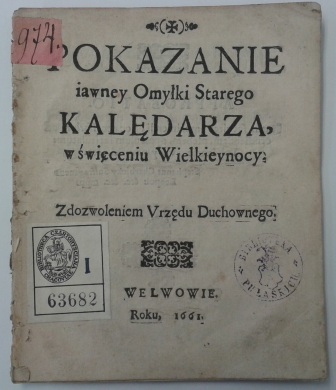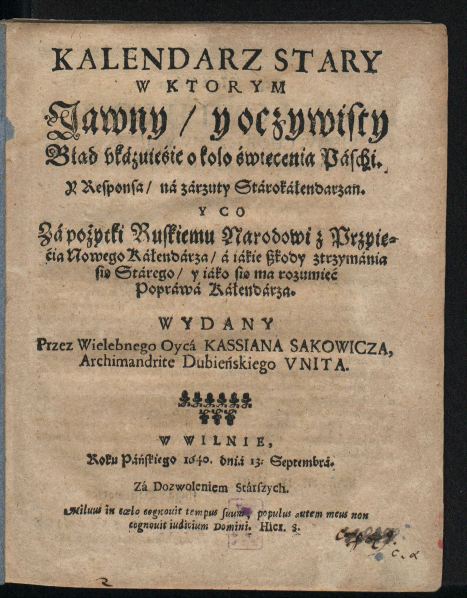All the readers of “Chronologia Universalis” probably heard at some point the 1969 hit by the Zager and Evans duo. In it, the musicians propose a pessimistic, if not apocalyptic, insight into the relatively distant future, asking questions about such important issues as the survival of humankind by the year 9525 and so on and so forth. At the moment of its premiere, the song somehow reflected all the Cold War-related uncertainties and concerns, just as did other kinds of popcultural texts preoccupied with apocalyptic visions and predictions. To say that I like the song would be an overstatement, yet I must confess I could not get it out of my head while I was working on one of the texts that belongs to the long line of polemical writings related to the introduction of the Gregorian calendar in the Polish-Lithuanian Commonwealth. And although I intend to include it in the critical edition of these sources, there are moments when I wonder whether this decision won’t turn as suicidal.
What I would like to propose you today is to make a thought experiment. Instead of two pop-rock musicians singing about what may happen in the distant future imagine a Catholic priest of Armenian origin, sitting in his studio and writing. The whole scene is settled in the city of Lviv somewhere in 1660’s. Jakub Gawath (1598-1679), the priest in question, is in his sixties and is already know as the author of a number of religious texts. Some of them will have to wait for their publication by the 1690’s, but at the moment when we meet Gawath he is working on something really special – the ultimate argument for the acknowledgement of the Gregorian calendar.
The harbinger of this argument was Gawath’s 1661 brochure entitled Pokazanie jawnej omyłki starego kalendarza w święceniu Wielkiejnocy (The Demonstration of the Blatant Error of the Old Calendar with regard to the Celebration of Easter). In it, Gawath developed a brief and rather loose line of argumentation about the reasons why the Gregorian calendar should be acknowledged by the Uniates and Orthodox Christians. Once again, following into the footsteps of his predecessors, Gawath made use of the standard arguments such as references to the early Christian synods, citations from the Church Fathers, scriptural arguments, etc. although he put them in a somewhat different form than the one employed by Joannes Broscius, Kasjan Sakowicz or even Jan Dubowicz. From the structure of The Demonstration it can be easily of observed that Gawath had some real difficulties in organizing this text around one idea and he could not resist the temptation to use all arguments that he had at hand. What the readers got in result is a loose combination of images and arguments of all possible kinds, a real mishmash which is still comprehensible, yet a bit annoying.

Jakub Gawath, The Demonstration of the Blatant Error of the Old Calendar…, Lviv 1661, title page; Cracow, Princes Czartoryski Library, shelfmark 63682 I
The function of The Demonstration, however, was to prepare the ground for the ultimate battle. In 1665 Gawath brought out the big guns although he masked them wisely with a verbal camouflage. If you see two titles, The Demonstration of Blatant Errors… and the other, i.e. A Supplement to Two Treatises on Calendar (Supplement dwóm traktacikom o kalandarzu), you quite naturally expect that the supplement will be simply a supplement, nothing more, nothing less and will be shorter than the basic text. But this is not the case of Gawath as his supplement is several times longer than his previous works on calendar and goes well beyond the standard polemical argumentation as it also includes several featuers of a computistical manual.
Gawath’s Supplement is a text difficult to read for a number of reasons. Although by the moment of its publication the Polish ortography has been adopted for print quite well and seemed to be pretty stable, the Supplement brings a set of quite puzzling attempts to write down words in a completely new, sometimes amusing, way. The same goes for punctuation. In the Old Polish prints it was based not on the logical division of the text, be it a sentence or paragraph, but on the intonation. In case of Gawath’s treatise (oh pardon, supplement to treatises) punctuation marks were used without any visible rules, some long sentences merge into one mega-sentence or sentence-like structure because either the author or the typesetter did not know where to put a full stop. Sometimes, just like in the case of the Oxford comma, the enumerations become rather confusing as it is difficult to determine wheter a series of words should be treated as a list of, let’s say, four items or a list of three items determining the fourth one – both options make sense and this is a real challenge for an editor. The general impression is that the text was prepared for print by a typesetter who got drunk or by an absolute newcomer to the profession. (Needless to say that there is no Erratum at the end of the brochure…)

Jakub Gawath, Supplement to the Two Treatises on Calendar…, Lviv 1665; Cracow, Princes Czartoryski Library, shelfmark 63681 I
However, once you get accustomed to the peculiarities of Gawath’s logic, punctuation and ortography, you can try to figure out what he had in mind and why he decided to publish his Supplement. It turns out that the basic idea was to make his readers aware of the long-distance consequences of the fact that the Orthodox Christians decided to keep the Julian calendar and treated the recognition of the new system of time reckoning as an act of treason against the tradition established at the Council of Nicaea in 325 A.D. A similar attempt has been already reported by Joannes Broscius in his Apology of the Roman Catholic Calendar, where the Cracow scholar suggested that if the calendrical divide lasts long enough, the Orthodox Christians and Uniates will celebrate their Easter in the summer. Broscius however, although he had all qualification to do this, did not decide to involve calculations or tables that would prove his readers that he was right. Such a paradox, if put in a witty way, could do its job as a link in the long line of argumentation. You can show the implications of this fact in few sentences and ask rhetorically your readers if they really want to sentence the next generations to the everlasting, totally errant celebration of the Easter. This could also gain you some respect among the learned who could share your love for puns and paradoxes and appreciate the knowledge of astronomy. Finally, it could also serve as a quite evocative argument to those who are less educated as the image of Easter celebrated in the summer, during the harvest, could be really appealing even to the imagination of less educated public.
Unlike Broscius, Gawath decided to do the opposite as he made a risky attempt to tell something what should be presented in a tabular form. At the moment of the introduction of the reform in 1582 the difference between the Julian and Gregorian calendars amounted to 10 days. To keep the spring equinox in its place, i.e. on the 21st of March, just as it was decided in Nicaea in the 4th century, the Gregorian calendar brought a new system of leap years, which eventually lead to the growth of difference between the two calendars. This could be easily shown in a neat and elegant table, as there is nothing difficult in showing the growing difference between these two systems in few colums.
Gawath took the road less taken and presented the tabular data in a narrative form. This decision resulted in a kind of an obscure litany to the old and new calendar, in which he enumerated the crucial moments in the future when the divergence between the two systems will be growing and provided some computistical calculations of the golden number and epacts, giving the exact dates of Easter that could be of use for the generations of Christians who would come hundreds or even thousands of years after his own generation. Needless to say that this makes his text really annoying: one, two or three paragraphs of this kind are fine and they give you the general idea, but the fourth, fifth … and the fifteenth make you a bit impatient and you start peeking at the next pages, just to make sure this sequence will finally conclude at some point. This is as if Gawath decided to bore his Orthodox oponents to death, or at least exhaust them to a point when they would be ready to admit that the Gregorian calendar is a much better and more precise tool for time reckoning than the old Julian calendar.

Gawath’s Supplement, p. 4-5, an example of his calendrical litany – evey paragraph is dedicated to a single year which plays significant role in his entire argument on the desynchronization of two calendars
The radicality of Gawath, however, consists not only in his attempt to rhetoricize something which is completely at odds with rhetoric, but in the fact that at some points he seems to suggest that he assumes quite an optimistic view that in the year 48900 A.D. we as a humankin will still be here on Earth, arguing about the dating of Easter and the legacy of the synod of 325 A.D.. Up to a point, this attitude seems to clash with the apocalyptic and millenarist tendencies of Gawath’s times, when the Second Coming and the Last Judgement seemed to be right behind the corner. If you assume that the date of the Easter in 48900 A.D. is really an issue, the perspective of salvation becomes nearly unavailable, especially for those who are particularly impatient. The long-term scenario outlined by this Armenian Catholic priest had obviously nothing to do with the doctrine of salvation and interpretation of the Scripture but it is an interesting paradox, however, how these two attitudes towards time coexisted – the impatient awaiting of the Second Coming and the quiet, yet still quite apocalyptic, calculations of the disorder of time in the 488th century C.E.
Maybe, then, if one is looking for some antecedences of apocalyptical images of the future in early modern texts, he or she should turn not only towards the literary works that offered imaginary narratives to the Moon and other celestial bodies or utopian visions of the future that would come within the period of two or three hundred years, but also to the texts that were created for completely different reasons and purposes.
If the coexistence of two systems of time reckoning in early modern Christianity caused so many difficulties, imagine the social consequences of the further desynchronization of calendars in the future. Thus, the Zager and Evans-style question, “In the year 252525, will the Easter be on time?” seems to promise quite an intriguing starting point for an apocalyptic novel.
P.S. Those of you who are awaiting the Part 2 of the series dedicated to the manuscript of Jan Latosz’s Przestroga are kindly asked to have patience. The next post will appear here within the next few days.


